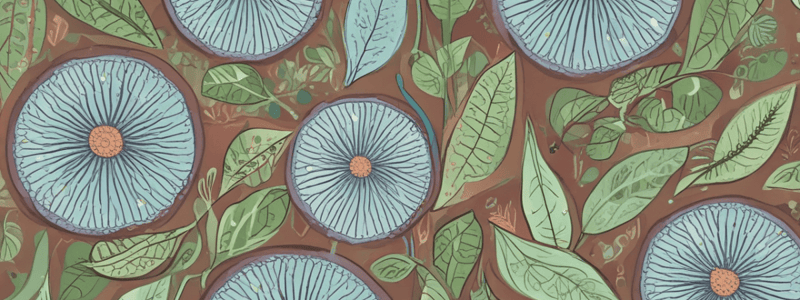Podcast
Questions and Answers
What is the main function of petals in a flower?
What is the main function of petals in a flower?
- To support the anther
- To attract pollinators (correct)
- To produce pollen
- To protect the bud
Which part of the flower protects the bud?
Which part of the flower protects the bud?
- Stigma
- Filament
- Sepals (correct)
- Petals
What is the term for the male reproductive organs in a flower?
What is the term for the male reproductive organs in a flower?
- Pistils
- Sepals
- Stamen (correct)
- Petals
What is the function of the stigma in a flower?
What is the function of the stigma in a flower?
What is a symbolic representation of a flower's structure?
What is a symbolic representation of a flower's structure?
Study Notes
Botany Terms
- Haploid: having a single set of chromosomes in each cell.
- Diploid: having two sets of chromosomes in each cell.
- Mitosis: cell division that produces two genetically identical cells.
- Meiosis: reduction division that produces four haploid reproductive cells.
Plant Reproduction vs. Animal Reproduction
- Plant life cycle: alternation of generations.
- Animal life cycle: no alternation of generations.
- Gametes in plants: haploid gametes.
- Gametes in animals: haploid gametes.
- Spores in plants: haploid spores.
- Spores in animals: no spores.
- Gametes made in plants: by haploid gametophyte, through mitosis.
- Gametes made in animals: by diploid organism, through meiosis.
- Spores made in plants: by diploid sporophyte, through meiosis.
Leaf Forms
- Simple leaf: 1 petiole, 1 leaf.
- Compound leaf: 1 petiole, 2 or more leaves.
Phyllotaxy
- Leaf arrangement in stem.
Leaf Venation
- No notes provided.
Leaf Margin
- No notes provided.
Flowers
- Incomplete flowers: lack some or all parts.
- Complete flowers: have all parts.
- Perfect flowers: have both male and female parts.
- Examples: grass flowers (incomplete, imperfect), tulip flowers (complete, perfect).
Flower Structure
- Petals are the colorful parts that attract pollinators
- Sepals are green, leaf-like structures that protect the bud
- Stamen consists of an anther that produces pollen and a filament that supports the anther
- Pistils consist of a stigma that catches pollen, a style that connects the stigma to the ovary, and an ovary that contains ovules (eggs) where fertilization occurs
Types of Flowers
- Complete flowers have all four parts: sepals, petals, stamen, and pistils
- Incomplete flowers lack one or more of the four parts
- Perfect flowers have both stamen and pistils
- Imperfect flowers have either stamen or pistils, but not both
- Monoecious flowers have separate male and female flowers on the same plant
- Dioecious flowers have male and female flowers on different plants
Flower Arrangement
- Floral formula is a symbolic representation of a flower's structure
- Flower arrangement refers to the way flowers are arranged on a stem
- Inflorescence is a cluster of flowers on a stem
Studying That Suits You
Use AI to generate personalized quizzes and flashcards to suit your learning preferences.
Related Documents
Description
Test your knowledge of botany concepts, including haploid and diploid cells, mitosis, meiosis, and plant reproduction. Learn about the differences between plant and animal reproduction.



